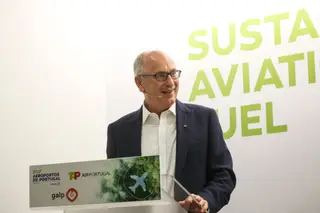The use of SAF (Sustainable Aviation Fuel) is expected to account for 63% of the total fuel used in the commercial aviation sector by 2050. The target, defined by the European Commission's 'ReFuelEU Aviation' initiative, part of the 'Fit for 55' package, aims to increase the supply and demand of SAF in the European Union, thereby ensuring that this type of fuel accounts for 2% of all aviation fuel by 2025, a percentage that should rise to 5% by 2030 and to more than two-thirds of the total two decades later. The strategic partnership recently announced by Galp, TAP and ANA Aeroportos aims to mark the beginning of the decarbonisation of air transport and to ensure a leading position in the development, production and supply of sustainable aviation fuels. “The aircraft of the future need sustainable fuel”, declared Andy Brown, at the ceremony held to execute the agreement.

“The aircraft of the future need sustainable fuel”
A flight with 35% less CO2 emissions took off from Lisbon for Ponta Delgada, in the Azores, marking the strategic partnership uniting Galp, TAP and ANA Aeroportos for the use of sustainable fuels. The aim of the three companies is to contribute to the decarbonisation of air transport
As far as the Galp CEO is concerned, this is a major milestone in the decarbonisation of the aviation sector, which, he recalls, accounts for 4% of the total amount of CO2 emitted in the European Union (EU). He highlights the importance of this transformation at a time when the gradual growth of aviation activity is expected, and which should be 40% greater than current activity by 2030.
39% of the fuel used on the flight between Lisbon and Ponta Delgada contained material of a renewable origin (HEFA), produced from waste, recycled used oils and other sustainable raw materials. The SAF used for the flight managed to reduce CO2 by 7.1 tons, equal to a 35% reduction in total emissions.
Although this is just a small step towards energy transition in the aviation industry, the Galp executive guaranteed that the company will be investing 50% of its CAPEX [CAPItal EXpenditure] in renewable energy and carbon neutral projects in the next few years, including advanced biofuels and other low-carbon fuels such as SAF. “Hydrogen, SAF and ammonia solutions will be part of the composition of the fuels of the future”, guarantees Andy Brown, who also reveals that Galp will have its own HEFA fuel plant by 2025, positioning itself as the second company to manufacture these products in Europe.

Andy Brown highlighted the importance of the use of SAF in a sector that accounts for 4% of total amount of CO2 emitted in the EU
In the words of Thierry Ligonnière, CEO of ANA Aeroportos, this partnership will give rise to significant developments in the decarbonisation process in the aviation sector and will help “promote positive mobility”. In other words, as he explains, due to it being an extremely polluting sector, this transformation will enable it to develop and grow with less impact on the environment. “Mobility has to be sustainable and we have to be able to reconcile travel with the impact on the planet”.
Aligned with their strategic partners, Christine Ourmières-Widener, CEO of TAP, acknowledges that “aviation is changing and TAP wants to be part of this historic process”. This flight to Ponta Delgada consolidates part of the national airline´s decarbonisation strategy, which “is committed to reducing the company´s environmental footprint”, she stresses. Other goals such as the renewal of the fleet to include more energy-saving engines and greater aerodynamics, and the replacement of ground support vehicles with hybrid vehicles, have already contributed to a monthly reduction of 30% in fuel costs, revealed the head of TAP.
Energy transition has also been part of ANA Aeroportos' environmental strategy since 2016. “We were the first airport operator to implement an environmental strategy at that time”, guarantees Thierry Ligonnière. The CEO provides examples of initiatives such as replacing airport lighting with LED lamps, renewing the fleet of low-emission vehicles, photovoltaic projects designed to reduce energy consumption by 25% to 30%, and monitoring the carbon footprint of planes on the ground, which has already been implemented at Lisbon Airport and will be replicated across the entire VINCI network.